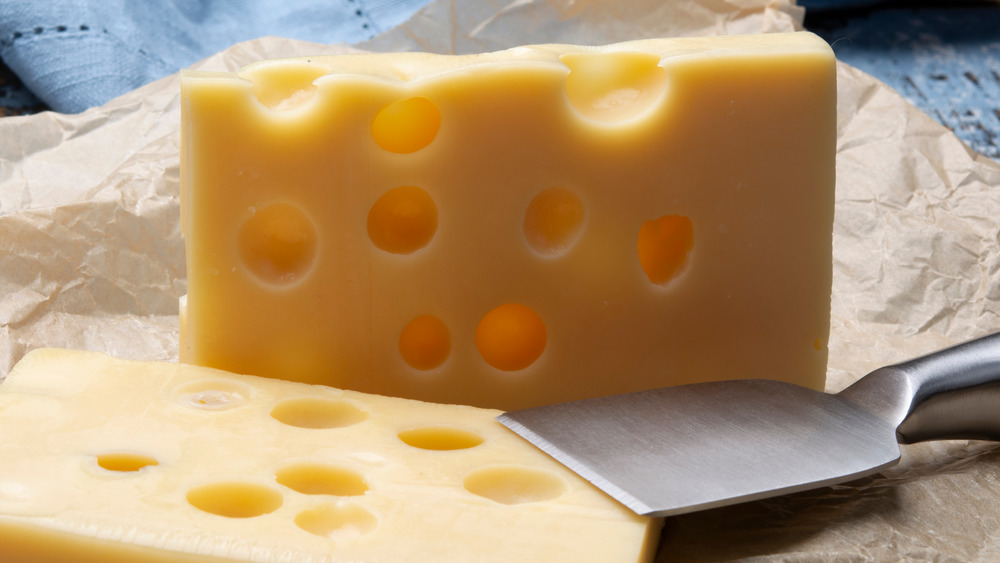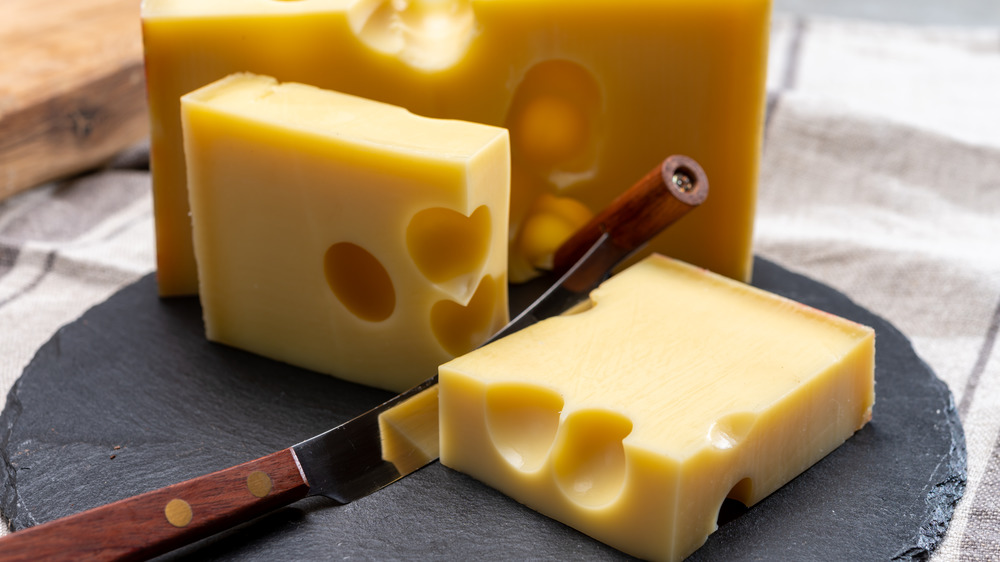What You Didn't Know About Emmental Cheese
For many, the notion of "Swiss cheese" can often conjure the dotted, thinly sliced, often slightly waxy, off-yellow cheese that is an immensely commonplace sandwich inclusion. Cheese from Switzerland, however, is much more than just that. That first cheese is actually referred to as "American Swiss Cheese," whereas another type of cheese is said to truly typify Switzerland and is incredibly well-regarded throughout the country: Emmental (sometimes called Emmentaler).
Wisconsin Cheeseman notes that "in Switzerland, there is no 'Swiss Cheese'; instead, there are a number of alpine cheeses — Emmentaler, gruyere, fontina, and others — from different regions." Furthermore, it's acknowledged that gruyere has some French influence and fontina has Italian influence, but Emmental is primarily German.
Cheeses from Switzerland came to American in the mid-1800s, as Wisconsin Cheeseman tells us, "when Swiss immigrants brought the traditional Emmentaler cheese recipe with them," originally settling in New York and then — for some families — moving to Wisconsin. According to The Spruce Eats, Emmental is a "semihard Swiss cow's milk cheese" and it can be "traced back to the 13th century in the valley of the river Emme in the Swiss canton or region of Bern." It is sweet, nutty, and relatively mild, with an inedible rind. The name is a combination of German words, meaning river and valley. It is Switzerland's oldest cheese, and there are particular markers to ensure its high quality, including "protected designation of origin" status, or PDO.
How is Emmental cheese made?
The cows that produce the cheese are exclusively fed grass and hay, and there are no additives in the end product. Culture Cheese Magazine also notes that milk for production "cannot come from cows that have been fed silage," that the milk must stay at a particular temperature, and it must "be kept for [no] longer than 18 hours prior to the start of cheesemaking." It's often made with raw, unpasteurized milk (via The Spruce Eats).
Castello Cheese notes that is has "tones of ripe fruit and hazelnuts," isn't acidic, and can be enjoyed in myriad ways. The raw milk is combined with whey and rennet, resulting in curd which is then "separated by whisks, placed in molds, and drained of any excess whey." After about two months of aging, the cheese begins to morph into the Emmantel cheese that is so widely cherished. Of course, the extent of aging can differ, resulting in a deepening and strengthening of the flavor. (Believe it or not, Wisconsin Cheeseman relates that a full wheel of Emmental cheese can weight as much as 200 pounds.)
The specifity of the eyes
Emmental's signature holes, or eyes, are a result of the cheese's fermentation process. The holes are formed when "propionic bacteria feeds on the lactic acid and releases bubbles of carbon dioxide during the aging process." The holes are no joke; the official website for the US Department of Agriculture notes that a "grade A Emmental cheese" must have eyes that are "3/8 to 13/16 inch in diameter." Cheeses from Switzerland notes that Emmantal's holes "range from the size of cherries to the size of nuts."
The Spruce Eats also notes that Emmental is high in calcium — as are most cheeses — and also contains copper and phosphorus. It is commonly added to fondue, but is also an excellent melting cheese, so it's also delicious on anything from grilled cheese to roasted vegetables to a cheeseburger.
The next time that you're looking for a mild, smooth, richly flavored cheese that melts beautifully, look no further than Emmental. Or go retro and make a fondue. You can't go wrong with that.


